UCSF's Academy of Medical Educators Celebrates a Decade of Innovation
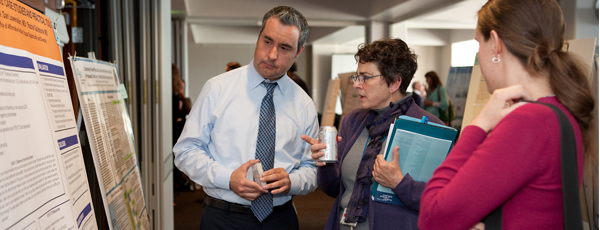
Rene Salazar, MD, assistant clinical professor of medicine, presents his poster to Helen Loeser, MD, associate dean for curriculum at the UCSF School of Medicine, and others during the academy's ninth annual Education Day in April 2010.
Teaching has long been extolled as the heart and soul of academic medicine, but over the years, economic pressures have encouraged medical schools to focus on their research and clinical missions, often overshadowing the educational mission.
In response, in 2000, educational leaders at UCSF’s School of Medicine established a new organization to ensure, highlight and uplift the value of teaching. This year, that entity, the Haile T. Debas Academy of Medical Educators, celebrates its first decade.
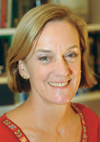
Molly Cooke, MD. Photo by Noah Berger
Dedicated to creating an environment that enhances the quality of teaching and the status of medical educators at UCSF, the academy’s guiding principles are to innovate and improve education, provide service to the school and fellow educators, and honor teaching excellence. As one of the first cross-departmental programs of its kind in the United States, the academy is nationally recognized as an effective model for supporting and advancing the educational mission of academic medical centers.
This year, the academy reflects on its first ten years, especially on its local and national impact. Although there is much to celebrate, there are also significant challenges, both old and new, facing medical educators. Today, the academy is well positioned and actively working to ensure that UCSF fulfills its critical mission of providing an outstanding, state-of-of the art education for the nation’s future physicians – a mission that thrives, rather than erodes, in the face of ongoing fiscal challenges and an uncertain future health care system.
Supporting Educational Excellence
Complex changes in the funding of clinical care and the importance of research over the past several decades tended to overshadow the core activity of education. While both clinical care and research bring revenue and other resources, and prestige to medical school departments, education frequently was seen as a secondary activity, which primarily consumed time and resources.
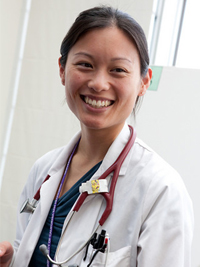
UCSF faculty, residents and students participate in Education Day.
Even though medical schools generally compensate departments for teaching activities, this funding is rarely related to the quality or amount of teaching provided. In addition, funding is not necessarily attached to the salaries of those actually developing curricula and handling the bulk of the teaching enterprise.
“Something, which thankfully took the form of the academy, was needed to ensure that the direct educational mission of the medical school was actively supported by its best and brightest educators,” said inaugural academy member Lowell Tong, MD. “Often, educators were somewhat marginalized in their departments, and there was actually suspicion by some faculty not in the thick of teaching that department resources towards education were simply not needed. Bringing educators from all departments together to serve as a nidus for educational excellence, quality improvement and innovation was a brilliant move.”
To counteract this inequity and restore balance to the three-fold mission of academic medicine – providing clinical care, advancing the science of medicine, and training the next generation of physicians – the academy’s founders sought to radically challenge the traditional “departmental” structure of academic medicine. They saw the opportunity to place medical education and its mission in the forefront by establishing a “department” of medical education. Thus, the academy was created to serve as a “second home” for medical educators and develop programs to enhance the status of teachers, promote and reward teaching excellence, foster curricular innovation, and encourage scholarship in medical education.
Transcending Traditional Departmental Boundaries
Guided by the vision of Haile Debas, MD, former UCSF chancellor and dean of the School of Medicine, and Molly Cooke, MD, founding director, the academy has made many impressive achievements over the past decade. From the first cohort of 24 members in September 2001, the academy has grown to 87 members who represent five core teaching sites at UCSF and 20 of the school’s 28 departments.
Members serve as the academy’s backbone and, as such, are expected to participate in academy governance, programs and events, and further excellence in medical education throughout the broader teaching community. Across the school, members are mentors to faculty, residents and others interested in developing as medical educators, and serve as consultants to courses, clerkships and departments that are working to strengthen their teaching.
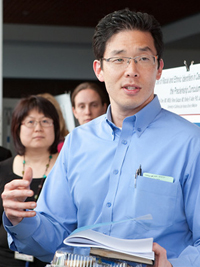
Members of the campus community discuss curriculum development and research at UCSF.
The steady growth in membership over the past decade reflects a sustained interest on the part of the school’s faculty and points to the need that the academy fills. “We’ve all been really impressed with our colleagues’ level of interest, especially in light of the fact that this is a service as well as an honor organization,” said Andy Josephson, MD, academy membership chair. “This demonstrates the real need for an organized community of educators that transcends traditional departmental boundaries.”
“The academy has developed a set of programs over the past decade that we feel has elevated the importance of medical education," said inaugural academy member Susan Masters, PhD. "It's great to see students involved in Education Day, junior faculty serving as principal investigators on Innovations Funding grants, and academy members sharing experiences about how to improve teaching methods.”
Among programs developed and implemented by the academy are:
- Innovations Funding, an intramural grant program that promotes curricular innovation at UCSF;
- the endowed chair program, which provides a dedicated source of income to support the innovative educational activities of chair holders; and
- the Teaching Improvement-Teaching Observation Program, which provides peer mentorship opportunities for faculty across the school.
Additionally, the academy supports a variety of events and awards to draw attention to and showcase the work of medical educators at UCSF. Events include the annual academy-sponsored Education Day; seasonal academy-wide meetings that are open to members and guests; and ad hoc mini-conferences. Awards include the Excellence in Teaching Awards, the Cooke Award for the Scholarship of Teaching and Learning, and the Boyden Award, which recognizes exemplary staff service to medical education.
“I have been truly impressed with the work of the Academy,” said Bradley Sharpe, MD, who was inducted into the academy this past September. “Teaching has long been a strong interest of mine, and the Academy provides resources, support and a community of educators, which are incredibly valuable.”
On a national level, the academy fosters excellence in medical education through the Academies Collaborative, an informal consortium of universities and medical schools with established academies or an interest in forming one. Co-founded by the UCSF and Harvard academies in 2001, the collaborative provides a forum to share new approaches to improving medical education and creating cultural change in academic medicine. By discussing common issues and sharing experiences, the institutions in the Collaborative have learned much from one another and strengthened the organizational change initiated by the growing academies movement.
“As a member of one of the country’s older academies, it is exciting to be able to share our experience and network with medical schools at all stages of development,” said David Irby, PhD, academy member. “It is particularly gratifying to see the ‘academies movement’ expand nationally and internationally, and to know that UCSF played a part in that growth.”
Looking to the Future
Medical educators today face old as well as new challenges, within UCSF and nationally. The ongoing recession has placed significant budgetary constraints on universities. Medical schools and their educational activities, along with clinical care and biomedical research, are being examined to determine if more efficient systems can be developed.
In an environment where decisions are increasingly being driven by quality and safety metrics, there is growing insistence on demonstrating that teaching enhances learners’ ability to achieve excellent patient outcomes. Additionally, exciting new ideas about workplace learning are challenging traditional structures of undergraduate medical education.
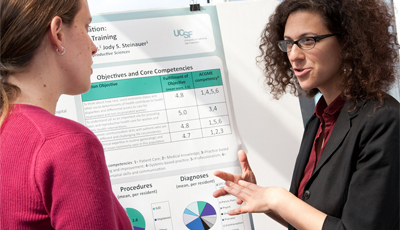
Two discuss their research projects during Education Day 2010.
“We are enormously proud of what we have accomplished over our first decade but, more importantly, are even more excited about the opportunities to advance the teaching mission of the school and to support its teachers in the coming years,” said Academy Director Cooke.
As educators look to the future, the academy will continue to advocate strongly for medical educators, to ensure that their contributions are recognized and their needs are considered alongside all of the important missions of the school.
Editor's note: James Beaudreau, MPA; Susan Masters, PhD; Lowell Tong, MD and Cynthia Ashe contributed to this report, which first appeared in the academy's March newsletter.
Photos by Elisabeth Fall/fallfoto.com